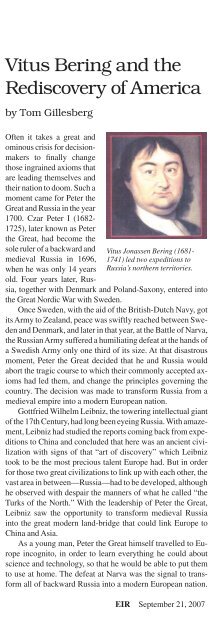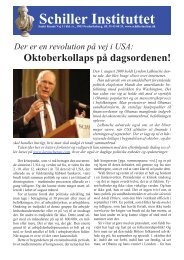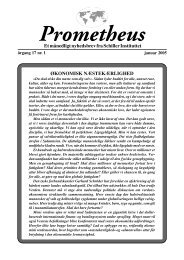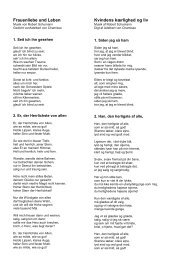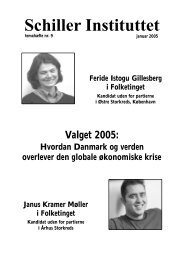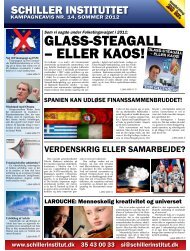Vitus Bering and the Rediscovery of America - schillerinstitut.dk
Vitus Bering and the Rediscovery of America - schillerinstitut.dk
Vitus Bering and the Rediscovery of America - schillerinstitut.dk
You also want an ePaper? Increase the reach of your titles
YUMPU automatically turns print PDFs into web optimized ePapers that Google loves.
<strong>Vitus</strong> <strong>Bering</strong> <strong>and</strong> <strong>the</strong><br />
<strong>Rediscovery</strong> <strong>of</strong> <strong>America</strong><br />
by Tom Gillesberg<br />
<strong>Vitus</strong> Jonassen <strong>Bering</strong> (1681-<br />
1741) led two expeditions to<br />
Russia’s nor<strong>the</strong>rn territories.<br />
Often it takes a great <strong>and</strong><br />
ominous crisis for decisionmakers<br />
to finally change<br />
those ingrained axioms that<br />
are leading <strong>the</strong>mselves <strong>and</strong><br />
<strong>the</strong>ir nation to doom. Such a<br />
moment came for Peter <strong>the</strong><br />
Great <strong>and</strong> Russia in <strong>the</strong> year<br />
1700. Czar Peter I (1682-<br />
1725), later known as Peter<br />
<strong>the</strong> Great, had become <strong>the</strong><br />
sole ruler <strong>of</strong> a backward <strong>and</strong><br />
medieval Russia in 1696,<br />
when he was only 14 years<br />
old. Four years later, Russia,<br />
toge<strong>the</strong>r with Denmark <strong>and</strong> Pol<strong>and</strong>-Saxony, entered into<br />
<strong>the</strong> Great Nordic War with Sweden.<br />
Once Sweden, with <strong>the</strong> aid <strong>of</strong> <strong>the</strong> British-Dutch Navy, got<br />
its Army to Zeal<strong>and</strong>, peace was swiftly reached between Sweden<br />
<strong>and</strong> Denmark, <strong>and</strong> later in that year, at <strong>the</strong> Battle <strong>of</strong> Narva,<br />
<strong>the</strong> Russian Army suffered a humiliating defeat at <strong>the</strong> h<strong>and</strong>s <strong>of</strong><br />
a Swedish Army only one third <strong>of</strong> its size. At that disastrous<br />
moment, Peter <strong>the</strong> Great decided that he <strong>and</strong> Russia would<br />
abort <strong>the</strong> tragic course to which <strong>the</strong>ir commonly accepted axioms<br />
had led <strong>the</strong>m, <strong>and</strong> change <strong>the</strong> principles governing <strong>the</strong><br />
country. The decision was made to transform Russia from a<br />
medieval empire into a modern European nation.<br />
Gottfried Wilhelm Leibniz, <strong>the</strong> towering intellectual giant<br />
<strong>of</strong> <strong>the</strong> 17th Century, had long been eyeing Russia. With amazement,<br />
Leibniz had studied <strong>the</strong> reports coming back from expeditions<br />
to China <strong>and</strong> concluded that here was an ancient civilization<br />
with signs <strong>of</strong> that “art <strong>of</strong> discovery” which Leibniz<br />
took to be <strong>the</strong> most precious talent Europe had. But in order<br />
for those two great civilizations to link up with each o<strong>the</strong>r, <strong>the</strong><br />
vast area in between—Russia—had to be developed, although<br />
he observed with despair <strong>the</strong> manners <strong>of</strong> what he called “<strong>the</strong><br />
Turks <strong>of</strong> <strong>the</strong> North.” With <strong>the</strong> leadership <strong>of</strong> Peter <strong>the</strong> Great,<br />
Leibniz saw <strong>the</strong> opportunity to transform medieval Russia<br />
into <strong>the</strong> great modern l<strong>and</strong>-bridge that could link Europe to<br />
China <strong>and</strong> Asia.<br />
As a young man, Peter <strong>the</strong> Great himself travelled to Europe<br />
incognito, in order to learn everything he could about<br />
science <strong>and</strong> technology, so that he would be able to put <strong>the</strong>m<br />
to use at home. The defeat at Narva was <strong>the</strong> signal to transform<br />
all <strong>of</strong> backward Russia into a modern European nation.<br />
EIR September 21, 2007
He launched a “head hunt” for capable European h<strong>and</strong>s <strong>and</strong><br />
minds that could help in <strong>the</strong> transformation. Among o<strong>the</strong>r<br />
projects, he sent people out to recruit a Russian navy. In 1703,<br />
Peter <strong>the</strong> Great founded a new city on territory conquered<br />
from Sweden, St. Petersburg on <strong>the</strong> Baltic coast, which was to<br />
become Russia’s window to Europe. In 1712, he elevated St.<br />
Petersburg to be <strong>the</strong> new Russian capital, <strong>and</strong> from that time<br />
on, Russia was a European power.<br />
Leibniz Becomes Peter’s Advisor<br />
In <strong>the</strong> course <strong>of</strong> <strong>the</strong> protracted Great<br />
Nordic War, Peter adopted Leibniz as an<br />
advisor to help in uplifting Russia through<br />
<strong>the</strong> promotion <strong>of</strong> scientific <strong>and</strong> technological<br />
progress. Before that point, Leibniz<br />
had tried to influence things in Russia<br />
through his extensive networks, <strong>and</strong> at <strong>the</strong><br />
end <strong>of</strong> November 1711, he finally managed<br />
to have an audience with Peter in Torgau,<br />
Saxony. At that meeting, Leibniz gave<br />
Peter an aide-mémoire that “presented a<br />
program consisting <strong>of</strong> plans for printing,<br />
trade <strong>and</strong> publishing, secondary schools,<br />
agriculture, research into <strong>the</strong> magnetic<br />
declinations <strong>of</strong> Russian soil, research into<br />
Slavonic languages, promoting <strong>the</strong> manufacture<br />
industry <strong>and</strong>, most important <strong>of</strong> all,<br />
founding an academy. O<strong>the</strong>r topics brought<br />
up during <strong>the</strong> audience concerned <strong>the</strong> mapping<br />
<strong>of</strong> <strong>the</strong> Siberian l<strong>and</strong>mass <strong>and</strong> improving sea- <strong>and</strong> l<strong>and</strong>routes,<br />
Leibniz’s plan for sending an expedition to explore <strong>the</strong><br />
border between Asia <strong>and</strong> North <strong>America</strong>. . . .” <br />
Leibniz later met Peter again <strong>and</strong> was “<strong>of</strong>fered <strong>the</strong> opportunity<br />
to be <strong>the</strong> Solon <strong>of</strong> Russia” when he was appointed a<br />
Privy Councillor to Russia in Carlsbad, one year later. From<br />
<strong>the</strong>n on, Leibniz corresponded with high <strong>of</strong>ficials at <strong>the</strong> Russian<br />
court, even though he never travelled to Russia. In 1716,<br />
when Peter visited <strong>the</strong> French Academy in Paris during a trip<br />
to Europe, <strong>the</strong> Academy brought up Leibniz’s idea <strong>of</strong> investigating<br />
<strong>the</strong> East, <strong>and</strong> asked Peter’s permission to explore <strong>the</strong><br />
border between Asia <strong>and</strong> North <strong>America</strong>. At <strong>the</strong> time, Peter<br />
refused, insisting that Russia would do so by itself.<br />
<strong>Bering</strong> <strong>and</strong> <strong>the</strong> Kamchatka Expedition<br />
Fortunately, <strong>the</strong> influence <strong>of</strong> Leibniz’s ideas at <strong>the</strong> Russian<br />
court continued after his death in 1716. In 1724, Peter <strong>the</strong><br />
Great gave <strong>the</strong> order to fulfill Leibniz’s dream <strong>of</strong> establishing<br />
a Russian Academy <strong>of</strong> Sciences, <strong>and</strong> in early 1725, just five<br />
weeks before his own death, Peter signed <strong>the</strong> instructions to<br />
. Markku Roinila, “Leibniz <strong>and</strong> <strong>the</strong> Great Mission: Russia” www.helsinki.<br />
fi/~mroinila/russia.htm<br />
. Elisabeth Hellenbroich, “G.W. Leibniz <strong>and</strong> <strong>the</strong> Ecumenical Alliance <strong>of</strong> All<br />
Eurasia” Fidelio, Fall 1996.<br />
Library <strong>of</strong> Congress<br />
Gottfried Wilhelm Leibniz (1646-1716)<br />
urged Peter <strong>the</strong> Great to set up a Russian<br />
Academy <strong>of</strong> Sciences.<br />
send an expedition to map out Eastern Siberia <strong>and</strong> discover<br />
<strong>the</strong> connection between Asia <strong>and</strong> North <strong>America</strong>. This expedition<br />
was to be led by <strong>the</strong> Dane <strong>Vitus</strong> <strong>Bering</strong>.<br />
At that time, <strong>Vitus</strong> Jonassen <strong>Bering</strong> (1681-1741) had been<br />
in Russian service for 22 years. He was born in <strong>the</strong> little Danish<br />
city <strong>of</strong> Horsens, where his fa<strong>the</strong>r was customs <strong>of</strong>ficer <strong>and</strong><br />
churchwarden. At an early age, he went to sea <strong>and</strong> travelled to<br />
both <strong>the</strong> Danish East Indian <strong>and</strong> West Indian colonies, <strong>and</strong> he<br />
learned how to comm<strong>and</strong> a ship <strong>and</strong> draw<br />
maps. In 1703, he was in Amsterdam<br />
searching for new adventures <strong>and</strong> responsibilities<br />
when he met <strong>the</strong> Norwegian<br />
Cornelius Cruys, a vice admiral in<br />
<strong>the</strong> Russian service, <strong>and</strong> he became one<br />
<strong>of</strong> <strong>the</strong> many Danish <strong>and</strong> Norwegian sailors<br />
recruited into <strong>the</strong> navy that Peter <strong>the</strong><br />
Great was building at <strong>the</strong> time. <strong>Bering</strong><br />
was a participant in <strong>the</strong> Russian fight<br />
against Denmark’s traditional arch-enemy,<br />
Sweden, until <strong>the</strong> Great Nordic War<br />
ended with <strong>the</strong> Swedish-Russian peace<br />
in 1721.<br />
In 1725, <strong>Bering</strong>, who had been<br />
seeking for some time <strong>the</strong> opportunity<br />
to take on more leadership, was happy<br />
to take charge <strong>of</strong> <strong>the</strong> Kamchatka expedition.<br />
Peter’s instructions to him from<br />
Dec. 23, 1724, ordered him to travel to<br />
<strong>the</strong> east coast <strong>of</strong> Kamchatka <strong>and</strong> <strong>the</strong>re<br />
to: 1) build one or two ships; 2) go north <strong>and</strong> find out how<br />
<strong>the</strong> coast ends; 3) go to a European-controlled city, find out<br />
to whom it belongs, make a map, <strong>and</strong> come back home.<br />
Since <strong>the</strong> Russian Academy <strong>of</strong> Sciences was too young to<br />
be involved in this so-called First Kamchatka Expedition,<br />
<strong>the</strong> science <strong>of</strong> <strong>the</strong> matter was left to <strong>Vitus</strong> <strong>Bering</strong>.<br />
How is it possible that such a top-priority, top-secret sensitive<br />
expedition was put under <strong>the</strong> comm<strong>and</strong> <strong>of</strong> <strong>the</strong> Dane,<br />
<strong>Bering</strong>? Well, that Dane had served faithfully in <strong>the</strong> Russian<br />
Navy for more than two decades, <strong>and</strong> Peter likely thought he<br />
was <strong>the</strong> only person capable <strong>of</strong> carrying out such an “impossible”<br />
expedition. Of course, <strong>Bering</strong> must have excelled in his<br />
comm<strong>and</strong> duties up to that point <strong>and</strong> proven himself extremely<br />
capable in seafaring <strong>and</strong> as a map-maker. But this expedition<br />
was not just about sailing a ship. It was about leading a<br />
gr<strong>and</strong> expedition under <strong>the</strong> most extreme circumstances, <strong>and</strong><br />
with very little help from civilization along <strong>the</strong> way.<br />
Before <strong>the</strong> “real” expedition could be launched from <strong>the</strong><br />
eastern shore <strong>of</strong> Russia, one first had to get <strong>the</strong>re. That meant<br />
travelling across one-third <strong>of</strong> <strong>the</strong> globe, over <strong>the</strong> huge, virtually<br />
unpopulated Siberian l<strong>and</strong>-mass, with its hostile climate.<br />
As one progressed east, <strong>the</strong> conditions would get worse <strong>and</strong><br />
worse, <strong>and</strong> <strong>the</strong> people at h<strong>and</strong> to help out would get scarcer<br />
<strong>and</strong> scarcer. One would be a small army on a forced march<br />
through Hell, having to solve ever new problems.<br />
September 21, 2007 EIR Economics 39
Almost all <strong>of</strong> supplies for shipbuilding (except <strong>the</strong> wood),<br />
had to be carried along, before <strong>the</strong> ships could be built on <strong>the</strong><br />
east coast <strong>and</strong> <strong>the</strong> final scientific sea voyage could begin.<br />
Weapons, anchors, o<strong>the</strong>r iron parts, ropes, sails, equipment,<br />
<strong>and</strong> so on—everything had to be carried all <strong>the</strong> way from Tobolsk,<br />
Siberia. Only in very few cities <strong>and</strong> towns on <strong>the</strong> way<br />
could <strong>the</strong>y get supplies to keep <strong>the</strong> expedition alive. At Irkutsk,<br />
at mid-journey, <strong>the</strong>y would procure <strong>the</strong> grain to serve<br />
as supplies on board, <strong>and</strong> <strong>the</strong> pack horses to carry it <strong>the</strong> long<br />
distance from Yakutsk to Okhotsk. Transportation across Siberia<br />
had to go along different rivers <strong>and</strong>, in many cases, by<br />
rowing <strong>and</strong> pulling <strong>the</strong> barges upstream. In between rivers,<br />
<strong>the</strong>y trekked overl<strong>and</strong> with all <strong>the</strong>ir supplies. Arriving at <strong>the</strong><br />
next river, new barges or vessels had to be built. Corrupt local<br />
<strong>of</strong>ficials <strong>and</strong> <strong>the</strong> backward local labor force had to be mobilized<br />
(or forced) to help, so that <strong>the</strong> expedition could stay<br />
alive <strong>and</strong> advance.<br />
As insurmountable as all <strong>the</strong>se practical problems might<br />
seem, <strong>the</strong>re was an additional subjective factor. The expedition<br />
had to embark on a year-long journey into <strong>the</strong> great unknown,<br />
without even a map or a tried <strong>and</strong> tested travel route<br />
for a major part <strong>of</strong> <strong>the</strong> journey. They had to ga<strong>the</strong>r <strong>the</strong> intelligence<br />
needed along <strong>the</strong> way <strong>and</strong> adapt to circumstances. If<br />
<strong>the</strong>y survived all <strong>the</strong> tribulations <strong>of</strong> crossing Siberia, <strong>the</strong>y<br />
would embark on <strong>the</strong> great ocean to new unknown dangers<br />
<strong>and</strong>, possibly, a hostile reception by uncivilized tribes or a foreign<br />
power. Whe<strong>the</strong>r <strong>and</strong> when <strong>the</strong>y would make it back home<br />
was highly uncertain. Only a person with adventure in <strong>the</strong><br />
blood <strong>and</strong> an idea <strong>of</strong> his personal role to play as an historic individual<br />
in <strong>the</strong> service <strong>of</strong> mankind would leave <strong>the</strong> safe pleasures<br />
<strong>of</strong> St. Petersburg to lead such an expedition.<br />
For that reason, we Danes are proud that <strong>Bering</strong> was chosen<br />
to lead <strong>the</strong> mission. Respect for <strong>the</strong> Danish <strong>of</strong>ficers in <strong>the</strong> Russian<br />
Navy at <strong>the</strong> time must have been considerable, for not only was<br />
<strong>Vitus</strong> <strong>Bering</strong> chosen to lead this extraordinary expedition, but ano<strong>the</strong>r<br />
Dane, Martin Spangsberg, was installed as his second-incomm<strong>and</strong>.<br />
In February 1725, <strong>Bering</strong> left St. Petersburg, <strong>and</strong> after<br />
travelling through <strong>the</strong> relatively “civilized <strong>and</strong> populated” areas <strong>of</strong><br />
Russia, he arrived in Tobolsk. Here <strong>the</strong> expedition started out, as<br />
soon as Winter loosened its grip, on May 15, 1725.<br />
Getting to Kamchatka<br />
From Tobolsk, <strong>the</strong> river-jumping began. First <strong>the</strong> expedition<br />
sailed down <strong>the</strong> Irtysh, <strong>and</strong> up <strong>the</strong> Ob <strong>and</strong> Ket Rivers.<br />
They went overl<strong>and</strong> to Yeniseysk, <strong>and</strong> from <strong>the</strong>re by boat to<br />
<strong>the</strong> mouth <strong>of</strong> <strong>the</strong> Ilim River. Here, <strong>the</strong>y were to spend <strong>the</strong> Winter<br />
in Ilimsk, but <strong>Bering</strong> sent 39 men under Spangsberg’s<br />
comm<strong>and</strong> to Ust-Kut, where <strong>the</strong>y would build 15 barges for<br />
next year’s travel. During <strong>the</strong> Winter, <strong>Bering</strong> visited <strong>the</strong> nearby<br />
trading center, Irkutsk, to organize <strong>the</strong> supply <strong>of</strong> grain <strong>and</strong><br />
horses from <strong>the</strong> local governor, <strong>and</strong> to ga<strong>the</strong>r information on<br />
<strong>the</strong> fur<strong>the</strong>r hazardous travel route to Okhotsk. He was sternly<br />
warned not to meddle with <strong>the</strong> tribes too far north, because<br />
<strong>the</strong>y had <strong>the</strong> habit <strong>of</strong> killing Russian <strong>of</strong>ficials.<br />
In <strong>the</strong> Spring, <strong>the</strong> expedition united in Ust-Kut <strong>and</strong> travelled<br />
on barges down <strong>the</strong> Lena River to Yakutsk. Here <strong>the</strong>y<br />
split up. <strong>Bering</strong> travelled on horseback with a few people <strong>and</strong><br />
<strong>the</strong> grain supplies to Okhotsk, while Spangsberg transported<br />
<strong>the</strong> heavy equipment down <strong>the</strong> Lena <strong>and</strong> <strong>the</strong>n <strong>the</strong> hard way, up<br />
<strong>the</strong> Aldan <strong>and</strong> Maja Rivers, to a place called Yudoma Cross.<br />
From <strong>the</strong>re, he had to travel a couple <strong>of</strong> hundred kilometers<br />
overl<strong>and</strong> to get to Okhotsk.<br />
After rough times, with many men deserting <strong>and</strong> most <strong>of</strong><br />
his horses dying, <strong>Bering</strong>’s smaller expedition finally made it to<br />
Okhotsk. Most <strong>of</strong> <strong>the</strong> supplies had to be left under guard along<br />
<strong>the</strong> way. But before resting, <strong>Bering</strong>’s group had to build houses<br />
<strong>and</strong> storage space; <strong>the</strong>y needed lodgings for <strong>the</strong>mselves <strong>and</strong><br />
<strong>the</strong> o<strong>the</strong>r men <strong>the</strong>y awaited, in order to make it through <strong>the</strong><br />
Winter. (Okhotsk consisted <strong>of</strong> only ten small houses.) Meanwhile,<br />
Spangsberg, whose route was much tougher, got caught<br />
in <strong>the</strong> Siberian Winter. Two <strong>of</strong> his men, half dead, arrived at<br />
Okhotsk <strong>and</strong> reported that Spangsberg’s group was hanging by<br />
a thread. Only because <strong>the</strong>y had found <strong>the</strong> grain <strong>and</strong> dead horses<br />
left by <strong>Bering</strong> had <strong>the</strong>y so far survived.<br />
<strong>Bering</strong> put toge<strong>the</strong>r a rescue team, but its members refused<br />
to leave <strong>the</strong> safety <strong>of</strong> <strong>the</strong> camp. <strong>Bering</strong>, who is <strong>of</strong>ten accused<br />
<strong>of</strong> being too s<strong>of</strong>t towards his men, had to be rough. Gallows<br />
were erected <strong>and</strong> <strong>the</strong> men were warned that <strong>the</strong>y would<br />
be immediately hanged, <strong>and</strong> <strong>the</strong>ir families at home punished<br />
as well, if <strong>the</strong>y did not carry out <strong>the</strong>ir orders <strong>and</strong> save Spangsberg<br />
<strong>and</strong> his men. This pedagogy worked: The rescue team<br />
left, <strong>and</strong> all <strong>the</strong> men were saved.<br />
During <strong>the</strong> Winter, Spangsberg <strong>and</strong> 90 men went back with<br />
dog teams to retrieve <strong>the</strong> supplies <strong>the</strong>y had had to leave behind.<br />
At <strong>the</strong> same time, <strong>the</strong> ship Fortuna was being built, <strong>and</strong> by<br />
Spring, it was ready to sail supplies across <strong>the</strong> Okhotsk Sea to<br />
<strong>the</strong> western side <strong>of</strong> Kamchatcka. In late August, <strong>the</strong> last men<br />
<strong>and</strong> supplies were transported to Kamchatka, where 14 small<br />
houses comprised <strong>the</strong> village called Bolscheretsk. They <strong>the</strong>n<br />
used <strong>the</strong> Fall <strong>and</strong> Winter to cross over <strong>the</strong> mountains on <strong>the</strong><br />
Kamchatka Peninsula to Klyuchevskaya Sopka on <strong>the</strong> o<strong>the</strong>r<br />
side. At last, <strong>the</strong>y could begin building <strong>the</strong> ship for <strong>the</strong>ir expedition.<br />
Christened Gabriel, it was ready to set sail in July 1728.<br />
Looking at a map today, one asks, <strong>of</strong> course, why <strong>the</strong> expedition<br />
did not just sail south <strong>of</strong> Kamchatka Peninsula, instead <strong>of</strong><br />
making <strong>the</strong> difficult crossing over <strong>the</strong> mountains on Kamchatka.<br />
Had <strong>the</strong>y had a map, <strong>the</strong>y would have. But <strong>the</strong> area was uncharted,<br />
<strong>and</strong> at <strong>the</strong> time it was generally believed that <strong>the</strong> peninsula<br />
went much far<strong>the</strong>r south. Thus, <strong>Bering</strong> went overl<strong>and</strong>.<br />
The Search for <strong>America</strong><br />
On July 13, 1728, three <strong>and</strong> a half years after <strong>Bering</strong> left St.<br />
Petersburg, <strong>and</strong> after countless dangers <strong>and</strong> tribulations, <strong>the</strong><br />
expedition set sail <strong>and</strong> travelled up <strong>the</strong> Siberian coast. They<br />
mapped <strong>the</strong> coastline <strong>and</strong> met local tribes in small boats. On<br />
Aug. 13, <strong>the</strong>y could see <strong>the</strong> coastline turning to <strong>the</strong> west (fitting<br />
<strong>the</strong> description <strong>the</strong>y had from <strong>the</strong> locals) <strong>and</strong> <strong>the</strong>y were certain<br />
that Russia’s coast continued west <strong>and</strong> could not be connected<br />
40 Economics EIR September 21, 2007
The map shows <strong>the</strong> first <strong>and</strong><br />
second expeditions <strong>of</strong> <strong>Vitus</strong><br />
<strong>Bering</strong>, across nor<strong>the</strong>rn<br />
Russia to Okhotsk, <strong>and</strong> from<br />
<strong>the</strong>re across <strong>the</strong> Kamchatka<br />
Peninsula. The second<br />
expedition l<strong>and</strong>ed in<br />
<strong>America</strong> <strong>and</strong> determined<br />
that Eurasia <strong>and</strong> <strong>America</strong><br />
were not connected by l<strong>and</strong>.<br />
with <strong>America</strong>. They had just gone through <strong>the</strong> passage we today<br />
know as <strong>the</strong> <strong>Bering</strong> Strait, <strong>and</strong> would have seen <strong>the</strong> <strong>America</strong>n<br />
coast, but for foggy wea<strong>the</strong>r. <strong>Bering</strong> <strong>the</strong>n had to decide<br />
whe<strong>the</strong>r to follow <strong>the</strong> coastline westward, <strong>and</strong> try to make it to<br />
<strong>the</strong> Russian outpost <strong>of</strong> Nizhne-Kolymsk at <strong>the</strong> mouth <strong>of</strong> <strong>the</strong><br />
Kolyma River. That involved <strong>the</strong> danger <strong>of</strong> being caught in <strong>the</strong><br />
icy waters during <strong>the</strong> Siberian Winter. They decided not to take<br />
<strong>the</strong> risk, <strong>and</strong> instead turned around <strong>and</strong> returned safely to Klyuchevskaya<br />
Sopka, where <strong>the</strong>y spent <strong>the</strong> Winter.<br />
<strong>Bering</strong>, <strong>of</strong> course, was not satisfied. They had not found<br />
<strong>America</strong>. Local reports convinced him that <strong>the</strong>re was l<strong>and</strong> not<br />
far away to <strong>the</strong> east, because exotic foreigners had been encountered<br />
from time to time. Unfortunately, he was also under<br />
<strong>the</strong> influence <strong>of</strong> <strong>the</strong> <strong>of</strong>ficial maps <strong>the</strong>n in circulation in Europe,<br />
on which something called “Juan da Gama L<strong>and</strong>” (which<br />
Juan Vasco da Gama thought he had seen on a journey), was<br />
placed to <strong>the</strong> east <strong>of</strong> Kamchatka. In June 1729, <strong>the</strong>refore, <strong>Bering</strong><br />
sailed sou<strong>the</strong>ast on <strong>the</strong> Gabriel to seek Juan da Gama<br />
L<strong>and</strong> <strong>and</strong> <strong>America</strong>.<br />
But <strong>Bering</strong>’s expedition discovered no l<strong>and</strong>, <strong>and</strong> after<br />
searching for <strong>the</strong> <strong>America</strong>n coast for ten days, <strong>the</strong>y returned to<br />
<strong>the</strong> Kamchatka coast, mapped it, <strong>and</strong> found a perfect place for<br />
a future harbor, Avacha Bay. Then <strong>the</strong>y mapped <strong>the</strong> coast all<br />
<strong>the</strong> way back to Bolscheretsk, where <strong>the</strong>y arrived on July 2,<br />
1730. Leaving <strong>the</strong> extra supplies, <strong>Bering</strong> returned to Okhotsk<br />
<strong>and</strong> began <strong>the</strong> long trip back to St. Petersburg. Without <strong>the</strong><br />
burden <strong>of</strong> supplies, it was much easier, <strong>and</strong> on March 1, 1730,<br />
a little more than five years after embarking on his journey,<br />
<strong>Bering</strong> was back.<br />
<strong>Bering</strong> could be quite proud. Not only did he <strong>and</strong> most <strong>of</strong><br />
his crew survive this incredible journey, but he could report<br />
that Asia was not connected by l<strong>and</strong> with <strong>America</strong>. He also<br />
returned with extraordinarily precise maps <strong>of</strong> previously unknown<br />
areas. The precision <strong>of</strong> <strong>Bering</strong>’s maps would impress<br />
subsequent travellers, because even <strong>the</strong> longitude <strong>of</strong> <strong>the</strong> positions<br />
was correct, which was extremely difficult to get right.<br />
<strong>Bering</strong>, like all capable sailors at <strong>the</strong> time, was well acquainted<br />
with astronomy, as much <strong>of</strong> <strong>the</strong> travel was “astrogation”—<br />
navigation by use <strong>of</strong> <strong>the</strong> stars. But <strong>the</strong> extraordinary scientific<br />
precision <strong>of</strong> <strong>Bering</strong>’s work was <strong>the</strong> result <strong>of</strong> using two lunar<br />
eclipses in 1728 <strong>and</strong> 1729 to pinpoint <strong>the</strong> longitude.<br />
The Russian Academy <strong>of</strong> Sciences<br />
<strong>Bering</strong> was returning to a German-cultured St. Petersburg,<br />
where <strong>the</strong> Academy <strong>of</strong> Sciences was now up <strong>and</strong> running.<br />
The Academy was composed, among o<strong>the</strong>rs, <strong>of</strong> scientists<br />
who came from Halle, Germany, where <strong>the</strong>re was a strong<br />
Leibnizian tradition; <strong>the</strong>se Halle scientists helped to build a<br />
Russian scientific cadre. In Halle, <strong>the</strong>se networks were centered<br />
on August Hermann Francke, who ran orphanages called<br />
<strong>the</strong> Franckeschen Stiftungen, <strong>and</strong> who collaborated with Cotton<br />
Ma<strong>the</strong>r in Massachusetts. From <strong>the</strong>se circles came Daniel<br />
Gottlieb Messerschmidt, who later made important discoveries<br />
in Siberia, <strong>and</strong> Georg Wilhelm Steller, who were to join<br />
<strong>Bering</strong> on his second Kamchatka expedition. While <strong>the</strong><br />
Francke networks were sending scientists to help transform<br />
Russia, <strong>the</strong>y were also recruiting people to go to <strong>the</strong> <strong>America</strong>n<br />
colonies <strong>and</strong> help lay <strong>the</strong> foundations for what later became<br />
<strong>the</strong> United States <strong>of</strong> <strong>America</strong>—a nation founded on <strong>the</strong> Leibnizian<br />
notion that all men have certain inalienable rights,<br />
among those, life, liberty, <strong>and</strong> “<strong>the</strong> pursuit <strong>of</strong> happiness,”<br />
Leibniz’s term for making scientific <strong>and</strong> technological progress<br />
on behalf <strong>of</strong> mankind. <br />
. Edward Spannaus, “Leibniz, Halle, <strong>and</strong> <strong>the</strong> <strong>America</strong>n Revolution,” Fidelio,<br />
Spring 2003.<br />
September 21, 2007 EIR Economics 41
As Leibniz wrote to Russian Chancellor Golovkin on Jan.<br />
16, 1712: “Since my youth, it has been my goal, to work for <strong>the</strong><br />
glory <strong>of</strong> God for <strong>the</strong> growth <strong>of</strong> <strong>the</strong> sciences . . . in which I have<br />
in part succeeded through Godly grace, in that I made new discoveries<br />
in <strong>the</strong> Republic <strong>of</strong> Sciences . . . , I am constantly ready,<br />
to direct my thoughts to <strong>the</strong> great goal. And I have only sought<br />
a prince who has <strong>the</strong> same goal. And <strong>the</strong>rein I make no differentiation,<br />
nei<strong>the</strong>r in regard to <strong>the</strong> nation nor <strong>the</strong> party. . . . I<br />
would ra<strong>the</strong>r see <strong>the</strong>se sciences bloom strongly with Russians,<br />
than work only in a mediocre fashion in Germany.” <br />
The Academy <strong>of</strong> Sciences was not satisfied with <strong>the</strong> results<br />
<strong>of</strong> <strong>Bering</strong>’s expedition. After all, he did not find <strong>America</strong>,<br />
<strong>and</strong> <strong>the</strong>re was no absolute pro<strong>of</strong> <strong>of</strong> <strong>the</strong> fact that <strong>the</strong>re was no<br />
connection between Asia <strong>and</strong> <strong>America</strong>, because he had not<br />
gone all <strong>the</strong> way to <strong>the</strong> mouth <strong>of</strong> <strong>the</strong> Kolyma River. Fur<strong>the</strong>rmore,<br />
<strong>the</strong> Academy did not believe <strong>Bering</strong>’s report on <strong>the</strong><br />
nonexistence <strong>of</strong> Juan da Gama Isl<strong>and</strong>, <strong>and</strong> could not, <strong>of</strong> course,<br />
appreciate <strong>the</strong> precision <strong>of</strong> his maps. Many o<strong>the</strong>r questions<br />
remained open on <strong>the</strong> state <strong>of</strong> affairs in <strong>the</strong> eastern part <strong>of</strong> Russia<br />
<strong>and</strong> in <strong>America</strong>.<br />
Although he was not properly rewarded for accomplishing<br />
a successful expedition, <strong>Bering</strong> agreed that many important<br />
questions still needed to be answered. And he knew that<br />
although he was five years older <strong>and</strong> somewhat worn down by<br />
<strong>the</strong> hardships <strong>of</strong> <strong>the</strong> first expedition, <strong>the</strong> mission could not be<br />
accomplished unless he took responsibility for it. Therefore,<br />
<strong>Bering</strong> suggested a new expedition under his leadership that<br />
would answer all <strong>the</strong> outst<strong>and</strong>ing questions <strong>and</strong> map out <strong>the</strong><br />
unknown rivers <strong>of</strong> Russia. He proposed that <strong>the</strong> expedition<br />
travel to Kamchatka, where <strong>the</strong>y would build a ship <strong>and</strong> 1) sail<br />
along <strong>the</strong> west coast <strong>of</strong> <strong>America</strong>, 2) find <strong>the</strong> sea route from<br />
Kamchatka to <strong>the</strong> Amur River, <strong>and</strong> 3) map <strong>the</strong> coastline from<br />
<strong>the</strong> Ob to <strong>the</strong> Yenisei River, <strong>and</strong> from <strong>the</strong>re to <strong>the</strong> Lena.<br />
The Second <strong>Bering</strong> Expedition<br />
In December 1732, Czarina Anna signed <strong>the</strong> order for <strong>the</strong><br />
new expedition <strong>and</strong> ordered <strong>the</strong> comm<strong>and</strong>er in Okhotsk to begin<br />
ga<strong>the</strong>ring supplies <strong>and</strong> to build five or six ships. At <strong>Bering</strong>’s<br />
suggestion, this new expedition was greatly exp<strong>and</strong>ed,<br />
<strong>and</strong> it included members <strong>of</strong> <strong>the</strong> Academy <strong>of</strong> Sciences to help<br />
investigate multiple aspects <strong>of</strong> <strong>the</strong> new territory. The Great<br />
Nor<strong>the</strong>rn Expedition, as <strong>the</strong> new expedition was named, was<br />
to last from 1733 to 1743. Its mission was to: 1) map <strong>the</strong> entire<br />
Nor<strong>the</strong>rn Asian coastline, 2) map <strong>the</strong> route to Japan, <strong>and</strong> 3)<br />
explore <strong>the</strong> Pacific Ocean to <strong>the</strong> east <strong>of</strong> Kamchatka, <strong>and</strong> find<br />
Juan da Gama L<strong>and</strong> <strong>and</strong> <strong>America</strong>. <strong>Bering</strong> was also instructed<br />
to organize <strong>the</strong> local production <strong>of</strong> ropes <strong>and</strong> o<strong>the</strong>r supplies in<br />
faraway places to be used for shipbuilding. The expedition<br />
was also ordered to try <strong>and</strong> convince those foreigners <strong>the</strong>y<br />
would meet in <strong>the</strong> new territories to come under <strong>the</strong> protection<br />
<strong>of</strong> Russia. Fur<strong>the</strong>r, <strong>the</strong> scientists were to investigate minerals,<br />
ores, <strong>and</strong> so on, in <strong>the</strong> new territories <strong>and</strong> consider if <strong>the</strong>y<br />
. See note 2.<br />
might be <strong>of</strong> economic importance.<br />
<strong>Bering</strong>’s second-in-comm<strong>and</strong> from <strong>the</strong> first expedition,<br />
Martin Spangsberg, was to lead <strong>the</strong> part <strong>of</strong> <strong>the</strong> expedition that<br />
went to Japan; <strong>and</strong> a third Dane, Peter Lassenius, was put in<br />
charge <strong>of</strong> <strong>the</strong> expedition that started at <strong>the</strong> mouth <strong>of</strong> <strong>the</strong> Lena<br />
River. <strong>Bering</strong> was <strong>the</strong> overall leader, <strong>and</strong> he <strong>and</strong> <strong>of</strong>ficer Aleksei<br />
Chirikov were each to lead a ship on <strong>the</strong> expedition to<br />
<strong>America</strong>. But before that point, it would take <strong>the</strong> next eight<br />
years to start <strong>the</strong> mapping <strong>and</strong> construction projects <strong>and</strong> move<br />
<strong>the</strong> expedition, with all its men <strong>and</strong> equipment, over <strong>the</strong> 7,000<br />
km to Avacha Bay on <strong>the</strong> Kamchatka Peninsula.<br />
The involvement <strong>of</strong> <strong>the</strong> Academy <strong>of</strong> Sciences made this<br />
expedition much larger than <strong>the</strong> first one. The core consisted<br />
<strong>of</strong> 500 persons with families <strong>and</strong> 500 soldiers. Local assistance<br />
<strong>of</strong> up to 2,000 persons at a time was called upon. Because<br />
<strong>the</strong> expedition included prominent scientists <strong>and</strong> <strong>the</strong>ir<br />
families, <strong>the</strong>re was much more personal baggage <strong>and</strong> supplies<br />
to carry along, <strong>and</strong> <strong>the</strong> quality <strong>of</strong> lodging <strong>and</strong> o<strong>the</strong>r accommodations<br />
had to be higher. For <strong>the</strong> same reason, many more<br />
ships were needed, requiring larger amounts <strong>of</strong> materials <strong>and</strong><br />
supplies. At least 28 cannons, among o<strong>the</strong>r things, were<br />
brought along.<br />
The Great Nor<strong>the</strong>rn Expedition<br />
The large caravan left St. Petersburg in February 1733.<br />
<strong>Bering</strong> sent Spangsberg ahead to Okhotsk, where he arrived<br />
in <strong>the</strong> Spring <strong>of</strong> 1735. Despite <strong>the</strong> orders from Czarina Anna<br />
to build five or six ships, nothing had been done. Meanwhile,<br />
<strong>Bering</strong> oversaw <strong>the</strong> building <strong>of</strong> two ships in Tobolsk, that <strong>the</strong>n<br />
departed under <strong>the</strong> comm<strong>and</strong> <strong>of</strong> Lassenius for <strong>the</strong> Arctic Sea<br />
(<strong>the</strong>y never completed <strong>the</strong>ir mission).<br />
By 1737, <strong>Bering</strong> reached Okhotsk, where only two ships<br />
were ready to sail. Under heavy pressure from St. Petersburg<br />
to show results, <strong>Bering</strong> sent <strong>the</strong> two finished ships <strong>and</strong> his old<br />
vessel Gabriel to Japan under <strong>the</strong> comm<strong>and</strong> <strong>of</strong> Spangsberg.<br />
Even <strong>the</strong> labor that was meant to build his new ships had to be<br />
diverted to help ready <strong>the</strong> supplies for this trip to Japan. Then,<br />
from 1738 to 1740, two new ships, St. Peter <strong>and</strong> St. Paul, were<br />
built, <strong>and</strong> supplies made ready. Each ship had 14 cannons <strong>and</strong><br />
carried 76 men. In 1739, Ivan Yelagin was sent by <strong>Bering</strong> to<br />
<strong>the</strong> east coast <strong>of</strong> Kamchatka to build a base with houses <strong>and</strong><br />
supply depots at Avacha Bay, at a place later named Petropavlovsk,<br />
in honor <strong>of</strong> <strong>the</strong> two ships.<br />
On May 30, 1741, St. Peter <strong>and</strong> St. Paul, under <strong>the</strong> comm<strong>and</strong>s<br />
<strong>of</strong> <strong>Bering</strong> <strong>and</strong> Chirikov, finally left Petropavlovsk, each<br />
with five months’ supplies. They had expected to double <strong>the</strong><br />
total supplies so that <strong>the</strong>y could spend <strong>the</strong> Winter in <strong>America</strong>,<br />
but could not do so because a supply ship sank with half <strong>of</strong><br />
<strong>the</strong>ir supplies. In accordance with <strong>the</strong>ir instructions for <strong>the</strong> expedition,<br />
<strong>Bering</strong> <strong>and</strong> Chirikov <strong>the</strong>n sailed sou<strong>the</strong>ast to find<br />
Juan da Gama L<strong>and</strong>. Had <strong>the</strong>y sailed due east, <strong>the</strong>y would have<br />
reached what were later called <strong>the</strong> Aleutian Isl<strong>and</strong>s, which <strong>the</strong>y<br />
could have followed all <strong>the</strong> way to <strong>America</strong>. Had <strong>the</strong>y sailed<br />
north-nor<strong>the</strong>ast, <strong>the</strong>y would have had a much shorter journey.<br />
42 Economics EIR September 21, 2007
But because <strong>the</strong>ir instructions were to find Juan da Gama L<strong>and</strong>,<br />
<strong>the</strong>y took a long trip without sighting l<strong>and</strong>.<br />
Later a storm separated <strong>the</strong> two ships, <strong>and</strong> <strong>the</strong>y were on <strong>the</strong>ir<br />
own. On July 17, <strong>Bering</strong>’s crew sighted a mountain, later called<br />
Mount St. Elias, on <strong>the</strong> <strong>America</strong>n coast. Four days later, <strong>the</strong>y<br />
went ashore on Kayak Isl<strong>and</strong> to get freshwater. Here <strong>the</strong> scientist<br />
Steller, after heavy pleading, was allowed to go on l<strong>and</strong> to study<br />
<strong>the</strong> new continent for a gr<strong>and</strong> total <strong>of</strong> ten hours. As he later bitterly<br />
complained, it took ten years <strong>of</strong> travel for <strong>the</strong> expedition to<br />
get to this new continent, <strong>and</strong> science was only given ten hours<br />
to study it. <strong>Bering</strong> <strong>the</strong>n sailed north while mapping <strong>the</strong> coastline.<br />
With supplies running low, he decided on Aug. 10 not to spend<br />
<strong>the</strong> Winter in <strong>America</strong>, but to head back west. By <strong>the</strong>n, <strong>the</strong>y already<br />
had problems on board with scurvy.<br />
The End <strong>of</strong> <strong>Bering</strong>’s Journey<br />
In hindsight, it seems a shame that <strong>Bering</strong> did not simply<br />
set up a camp <strong>and</strong> winter over in <strong>America</strong> while investigating<br />
<strong>the</strong> area. But <strong>the</strong>ir supplies were low, <strong>and</strong> <strong>Bering</strong> <strong>and</strong> his crew<br />
<strong>the</strong>y had no idea <strong>of</strong> what <strong>the</strong> Winter would be like, or if hostile<br />
local tribes or powers would turn up <strong>and</strong> finish <strong>of</strong>f <strong>the</strong> expedition.<br />
Also, a sailing vessel depends on <strong>the</strong> winds. Had <strong>the</strong>y<br />
hesitated too long before turning back, <strong>the</strong>y might not make it<br />
before <strong>the</strong> Winter. It does not help humanity that you have<br />
travelled to <strong>the</strong> ends <strong>of</strong> <strong>the</strong> world, if you do not make it back<br />
to tell about it.<br />
<strong>Bering</strong> decided to head west, while continuing to map <strong>the</strong><br />
coastline <strong>and</strong> isl<strong>and</strong>s along <strong>the</strong> way. But, as <strong>the</strong>y continued<br />
west, encountering various adventures, <strong>Bering</strong> <strong>and</strong> most <strong>of</strong><br />
<strong>the</strong> crew fell ill with scurvy. On Nov. 10, too late in <strong>the</strong> year to<br />
still be out on <strong>the</strong> ocean, <strong>the</strong>y finally saw <strong>the</strong> isl<strong>and</strong> that was<br />
later named after him—<strong>Bering</strong> Isl<strong>and</strong>. They could hardly sail<br />
<strong>the</strong> ship, since scurvy had so taken its toll, that only ten men<br />
were still capable <strong>of</strong> st<strong>and</strong>ing up.<br />
They were hoping to l<strong>and</strong> on Kamchatka. But 12 men had<br />
already died <strong>and</strong> 49 were sick. They settled on <strong>the</strong> uninhabited<br />
isl<strong>and</strong>, <strong>and</strong> most <strong>of</strong> <strong>the</strong> men recovered. <strong>Bering</strong> was among<br />
those who died. Despite <strong>the</strong> hardships, <strong>and</strong> although a storm<br />
later smashed <strong>the</strong>ir ship, <strong>the</strong> rest <strong>of</strong> <strong>the</strong> expedition survived<br />
<strong>the</strong> Winter. Under <strong>the</strong> comm<strong>and</strong> <strong>of</strong> a Swede named Sven Waxell,<br />
<strong>the</strong>y built a smaller ship that allowed 46 <strong>of</strong> <strong>the</strong> original 76<br />
onboard to arrive at Avacha Bay on Aug. 27, 1742. They spent<br />
<strong>the</strong> Winter in Petropavlovsk, <strong>and</strong> arrived in Okhotsk <strong>the</strong> next<br />
year, much to <strong>the</strong> surprise <strong>of</strong> <strong>the</strong> local residents, who had given<br />
up hope <strong>of</strong> seeing <strong>the</strong> expedition again, <strong>and</strong> had sold <strong>of</strong>f <strong>the</strong><br />
personal belongings <strong>of</strong> expedition members.<br />
While <strong>Bering</strong> found his final resting place on <strong>the</strong> isl<strong>and</strong><br />
that came to bear his name, most <strong>of</strong> his crew made it back to<br />
Russia. Over <strong>the</strong> coming years, all <strong>the</strong> maps <strong>and</strong> scientific records<br />
slowly made <strong>the</strong>ir way back to St. Petersburg, <strong>and</strong> with<br />
much delay, to <strong>the</strong> rest <strong>of</strong> <strong>the</strong> world. Unfortunately, <strong>the</strong> scientific<br />
impulse had been weakened in Russia during <strong>the</strong> decade<br />
<strong>of</strong> <strong>the</strong> expedition, <strong>and</strong> it would take time before <strong>the</strong> sacrifices<br />
its members made were truly appreciated. One <strong>of</strong> <strong>the</strong> immediate<br />
effects, however, after <strong>the</strong> crew members came back with<br />
many rare furs <strong>and</strong> skins from <strong>the</strong>ir stay on <strong>the</strong> <strong>Bering</strong> Isl<strong>and</strong>,<br />
was that commercial expeditions were sent to Eastern Siberia,<br />
North <strong>America</strong>, <strong>and</strong> <strong>the</strong> isl<strong>and</strong>s in between, in a “gold rush” to<br />
hunt for more such furs. That secured those new territories for<br />
Russia, <strong>and</strong> Alaska came under Russian rule until 1867, when<br />
it was sold to Russia’s good friend <strong>and</strong> ally, <strong>the</strong> United States,<br />
for $7.2 million.<br />
‘Manifest Destiny’<br />
Gottfried Wilhelm Leibniz saw in Peter <strong>the</strong> Great <strong>the</strong> chance<br />
to transform Russia from a brutish <strong>and</strong> backward country into a<br />
modern European nation that could be a bridge between Europe<br />
<strong>and</strong> China, <strong>and</strong> that Chinese culture Leibniz respected so much.<br />
Key to <strong>the</strong> manifest destiny Leibniz envisioned for Russia was<br />
<strong>the</strong> establishment <strong>of</strong> a Russian Academy <strong>of</strong> Sciences, <strong>and</strong> <strong>the</strong><br />
sending <strong>of</strong> expeditions to discover <strong>and</strong> conquer <strong>the</strong> wild <strong>and</strong> unknown<br />
eastern part <strong>of</strong> Russia. As history had it, it was a Dane,<br />
<strong>Vitus</strong> <strong>Bering</strong>, who, nine years after Leibniz’s death, took on <strong>the</strong><br />
mission <strong>of</strong> leading <strong>the</strong> two expeditions through <strong>the</strong> vast Siberia.<br />
He also visited <strong>and</strong> mapped part <strong>of</strong> <strong>America</strong> <strong>and</strong> cleared <strong>the</strong> way<br />
for incorporating <strong>the</strong> Eastern Frontier <strong>and</strong> parts <strong>of</strong> North <strong>America</strong><br />
into <strong>the</strong> nation <strong>of</strong> Russia.<br />
Today, ano<strong>the</strong>r project that carries <strong>Bering</strong>’s name, <strong>the</strong><br />
<strong>Bering</strong> Strait Tunnel Project, is <strong>the</strong> key to fulfilling Russia’s<br />
manifest destiny <strong>of</strong> conquering Siberia <strong>and</strong> putting its vast<br />
raw material resources to use for mankind, while connecting<br />
<strong>the</strong> world’s two transcontinental powers in a strategic partnership<br />
that also fulfills <strong>the</strong> manifest destiny <strong>of</strong> <strong>the</strong> United States.<br />
The United States was not only created to secure <strong>the</strong> inalienable<br />
rights <strong>of</strong> life, liberty, <strong>and</strong> <strong>the</strong> pursuit <strong>of</strong> happiness for its<br />
own population, but as a power that could finally defeat imperialism,<br />
like that <strong>of</strong> <strong>the</strong> British Empire, <strong>and</strong> fulfill <strong>the</strong> hopes<br />
<strong>and</strong> aspirations in <strong>the</strong> rest <strong>of</strong> <strong>the</strong> world, throwing <strong>of</strong>f <strong>the</strong> shackles<br />
<strong>of</strong> <strong>the</strong> European oligarchy to have free <strong>and</strong> sovereign nations<br />
prospering through scientific <strong>and</strong> technological progress.<br />
The time has come for <strong>the</strong> United States to heed <strong>the</strong><br />
advice <strong>of</strong> its Leibniz, Lyndon H. LaRouche, Jr., <strong>and</strong> join Russia,<br />
India, <strong>and</strong> China in building a New Bretton Woods financial<br />
system with <strong>the</strong> Eurasian L<strong>and</strong>-Bridge <strong>and</strong> <strong>the</strong> <strong>Bering</strong><br />
Strait Continental Bridge as its backbone.<br />
In a decade or two, a Danish maglev net, now being discussed<br />
under <strong>the</strong> inspiration <strong>of</strong> <strong>the</strong> Schiller Institute, will be<br />
connected to maglev lines extending over <strong>the</strong> vast areas <strong>of</strong><br />
Russia, linking up with North <strong>America</strong> through <strong>the</strong> <strong>Bering</strong><br />
Strait tunnel. As for <strong>the</strong> Eurasian l<strong>and</strong> mass that took <strong>Bering</strong><br />
years to traverse, we will pass over it comfortably in less than<br />
a day’s time. From Alaska, <strong>the</strong> line will continue through Canada<br />
to a revitalized United States that once again has become<br />
<strong>the</strong> beacon <strong>of</strong> hope <strong>and</strong> temple <strong>of</strong> liberty for all mankind. And<br />
it will take place in a world where <strong>the</strong> promises <strong>of</strong> <strong>the</strong> <strong>America</strong>n<br />
Dream for <strong>the</strong> first time can be available to all men.<br />
The author heads <strong>the</strong> Schiller Institute in Denmark.<br />
September 21, 2007 EIR Economics 43


